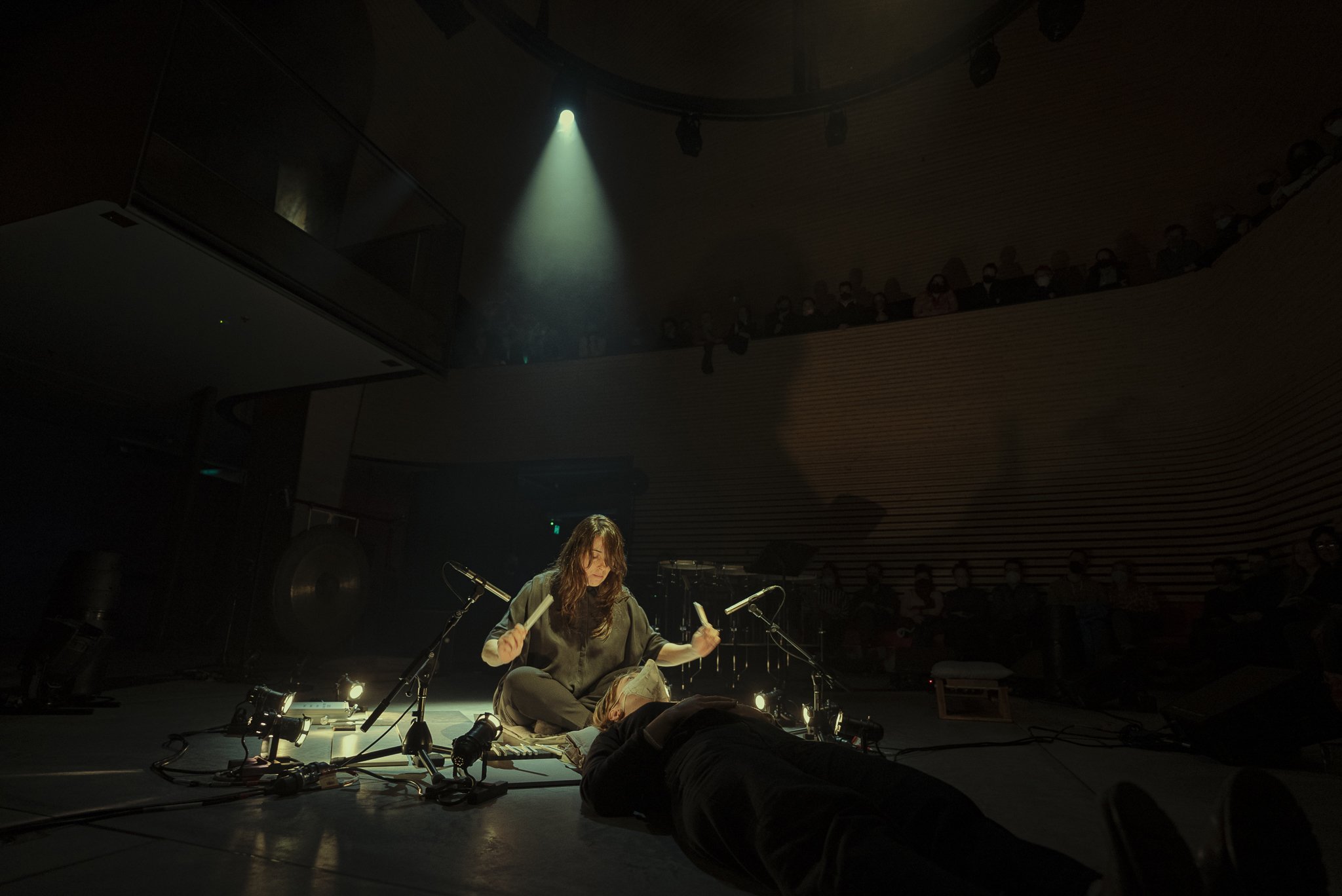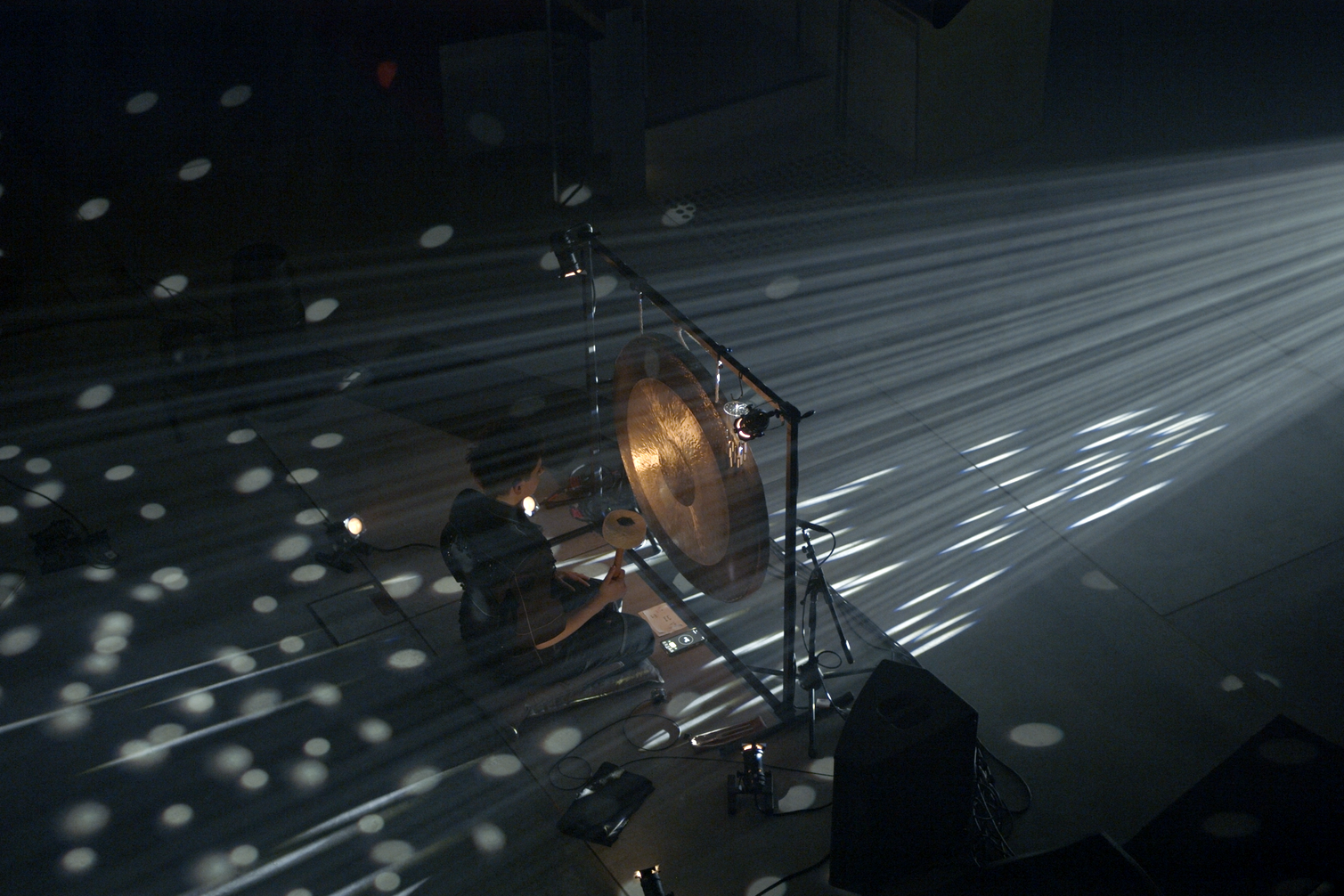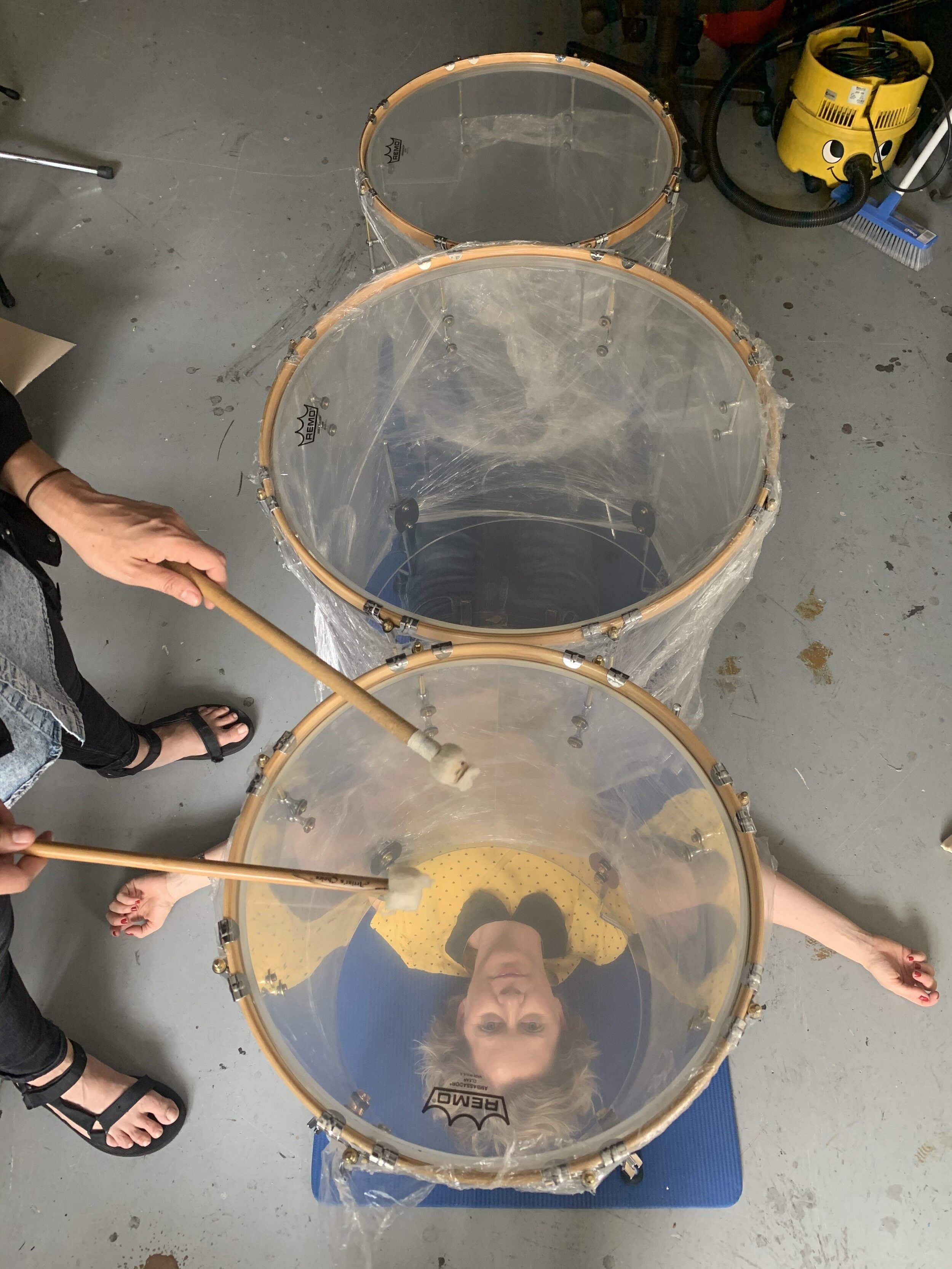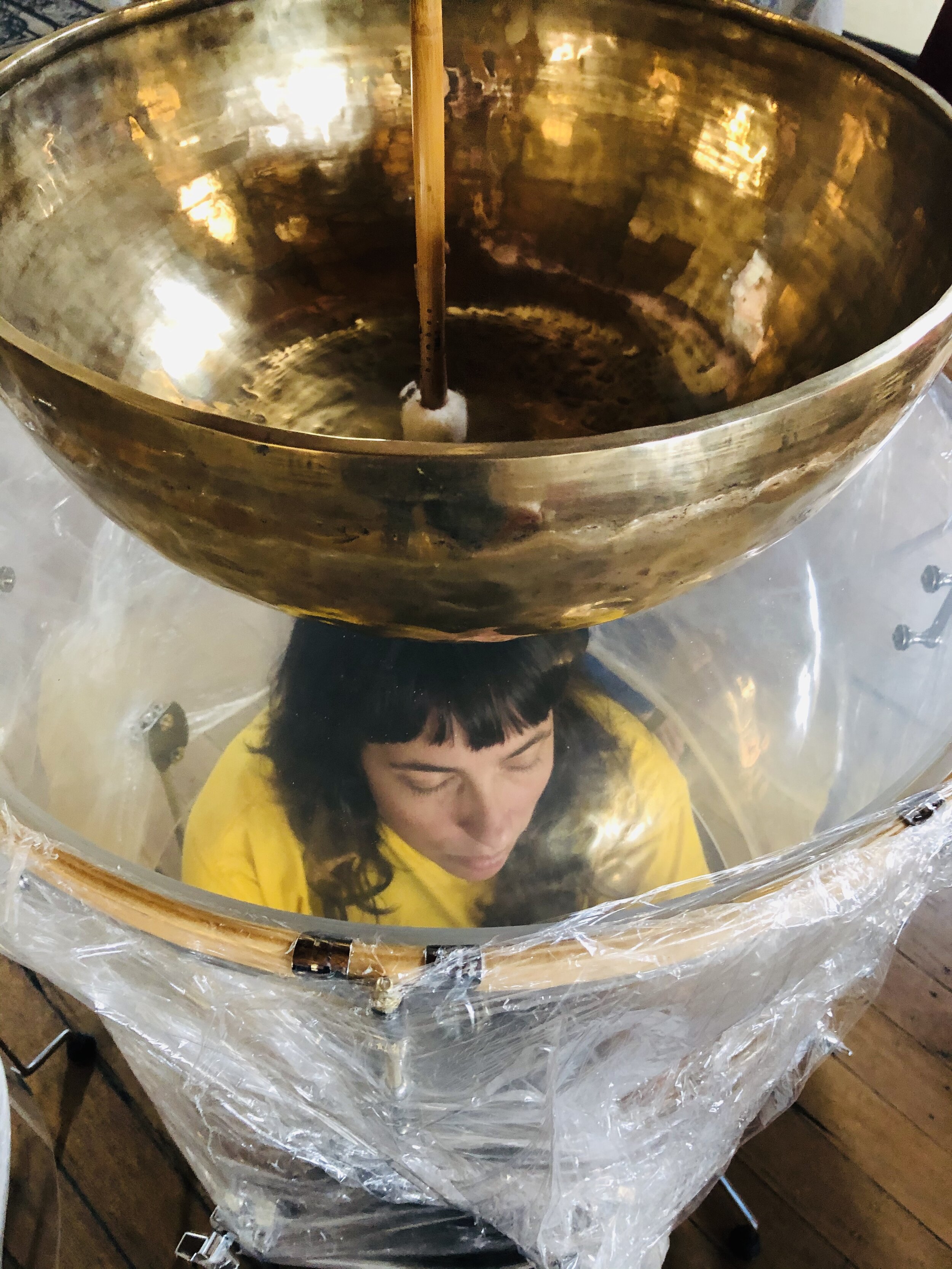Sound Touch
Music you can Feel
40 second video-short of Sound Touch
Sound Touch
Walk so silently that the bottoms of your feet become ears. (Pauline Oliveros)
What do you hear when you listen with your body? Imagine a music that bypasses your brain and penetrates your skin. A music that plays upon your nervous system like an Aeolian harp, as though you are a set of sympathetic strings stirred into resonance by distant touch.
Sound Touch explores vibration and the body. Sitting somewhere between a musical performance and a sound installation, join a lone percussionist as they guide your body through a tune-up, a sonic massage and a sound bath that will leave you sensitive and attuned to the world around you.
Sound Touch is a playful and provocative exploration of music’s capacity to affect one’s character. Traversing labyrinthine references from ancient acoustic myths and conspiracy theories to emerging medical technologies and sonic weapons, this enveloping experience is a sensory lesson in the vibratory nature of existence and the delicate art of listening.
Artists
Damien Ricketson - concept/composer
Niki Johnson - devising percussionist
Bree van Reyk - devising percussionist
Sally Blackwood - director
Fausto Brusamolino - lighting design
Benjamin Carey - sound design
Acknowledgements
Sound Touch was premiered at Phoenix Central Park, Sydney (27–30 July, 2022)
The work was created with the support of the Australia Council for the Arts and the Sydney Conservatorium of Music, University of Sydney.
Images: Jeremy Elphick [featuring percussionist Niki Johnson] and Jared Leibowitz [featuring percussionist Bree van Reyk] courtesy of Phoenix Central Park
Audience reception
Stunning! Feels like my atoms were zapped and rearranged - still buzzing.
The performance was one of the best I’ve ever seen.
It was chaos and unsettling and we left with a storm of emotions; beauty and a physical unease. We went for a long walk through the glowing city at night and discussed it for more than an hour.
Beautiful, engaging and thought provoking. Everything was superb.
Divine. Elevating. sympathetic.
Original, inspiring and deeply enriching.
It was beautiful, invigorating, thought provoking, uplifting.
The cumulative effect had a moment of ethereal release—a sheer joy.
[Feedback received via Phoenix audience surveys]
Highlights reel of Sound Touch [3:41]
About the work
Is a tone, once in existence, always in existence? Soundwaves diffuse infinitely in ever fainter ripples around the world but never stop. Imagine - every heartfelt song, every cry of joy and pain, every regretted utterance - an atmospheric disturbance reverberating in the white noise of history.
Just as you stare into the past when you look to the stars, do you hear into the past when listening for the slightest of sounds?
Thomas Edison, inventor of the gramophone, worked on an apparatus to record spiritual vibrations with the hope of chasing down the resonant traces of beautiful and important speeches through the ages. The problem of perception, he figured, was simply the limited instrument of our hearing - our ears.
That our ears and eyes can perceive only a small fraction of an infinite spectrum of vibrational energy raises the prospect that our bodies are soaked in a constant din of invisible and inaudible vibrations of which we are ordinarily unaware.
What does your body hear that your ears cannot?
Can your skin feel sound? Is it a coincidence that your skin shudders and goosebumps, hair follicles extending, to the caress of both sound and touch?
Can your internal organs hear? Low frequency soundscapes, felt deep within the abdomen, have sometimes been attributed to the perception of ghosts, while the tuning forks in this performance purport to stimulate your glands to secrete their chemical magic.
And what of the cellular level? The idea for this work began after meeting medical researchers manipulating cells by ‘exercising’ and ‘nanokicking’ them with sound.
That certain frequencies of vibration might subconsciously influence the body and brain at the near-molecular level have provided fertile ground for a rich and wondrous history of speculative theories. Plato believed the entire fabric of society was dependent on the correct notes being used: a phrygian scale will stir a man to bravery, while a mixolydian mode will make him ‘effeminate’. Meanwhile an internet search on musical tuning will quickly unearth the ‘great 440Hz conspiracy’. According to some, our standardised tuning reference, the oboe’s ‘A’ that cranks the orchestra into action, is part of a plot promoted by none other than Nazi Germany’s Joseph Goebbels and the Rockefeller Foundation to sow perennial discord in our community through incorrectly pitched music. In tuning circles, some propose a slightly flatter 432Hz (Verdi’s A) as an alternative because it is more mathematically pure, resonating as a harmonic of 8Hz, the supposed ‘Schumann Resonance’ or electromagnetic ‘beat’ of Earth itself.
The relationship between the frequencies of the audible realm being aligned, or in tune with greater universal systems lies at the heart of many of today’s sound healing practices. At one end of the spectrum, the vast cosmic frequencies of celestial systems, and at the other, the micro-atomic frequencies that make up our molecular interior can theoretically be transposed into our hearing range to unknot pollutants and leave our body more attuned to the natural world. Such pseudoscience often echoes classic ‘music of the spheres’ theories, a concept often spoken about in metaphors, but seldom realised with accuracy to specific frequencies.
In the golden era of 19th century Spiritualism, our nerves were imagined as taut strings that could be activated through sympathetic vibration, translating external frequencies into thoughts, feelings, and imagination: a machine for translating sensory vibration to consciousness. Central to this nerve-string conception is the idea that our body is made up of finely tuned antennae receptive to vibrations that sit beyond what is perceived by the ears and enable us to hear and feel over vast spatial and temporal distances. A well-tuned nervous system could be seen as the organ of utopic universal communicativeness.
In a piece of ‘sensation fiction’, popular at the time, the author Florence McLandburgh published The Automaton Ear (1878). Mirroring the real-world ambitions of Edison, the short story is narrated by a professor who creates a peculiar listening aid to tune into the vibrations of the past. Over the course of the story, the professor begins to question whether his curious ear trumpet does indeed amplify the sounds of the distant external world or his own interior: a projected hallucination of his own diseased fantasies.
Hearing is physiological, listening is psychological. Like an antenna without a tuner, as your hearing diminishes over time, do you not only lose your mechanical ability to hear, but also your mental capacity to extract the specific vibrations on which you wish to attend?
In a Tibetan story, the wandering Palzang, sitting for hours in a remote Himalayan valley, comes to understand that all the songs of the world - ever sung, and yet to be sung - exist within the soothing white noise of a waterfall.
The act of listening - of tuning in and attending to specific sounds in the wash of noise - is the act of creating.
The making of Sound Touch has been, above all, a lesson in listening. An attempt to extend my ability to listen beyond diminishing thresholds of perception. An attempt to feel sound as a multisensory phenomenon through the entire body. And an attempt to understand vibration as a force of resonance that connects us to one another and the environment in which we live.
—Damien Ricketson
Images: April Josie Photography
Watch the full show
Duration: 47:28
Creative development
Sound Touch creative development made possible with the support of the Australia Council for the Arts and the Sydney Conservatorium of Music, University of Sydney
Creative development
Sound Touch creative development made possible with the support of the Australia Council for the Arts and the Sydney Conservatorium of Music, University of Sydney








































